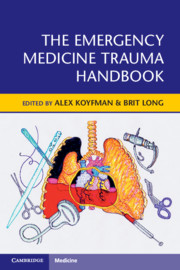Book contents
- The Emergency Medicine Trauma Handbook
- The Emergency Medicine Trauma Handbook
- Copyright page
- Contents
- Contributors
- Preface
- Disclaimer
- Chapter 1 General Approach to Traumatic Injuries
- Chapter 2 Trauma Airway
- Chapter 3 Transfusion in Trauma
- Chapter 4 Trauma in Pregnancy
- Chapter 5 Pediatric Trauma
- Chapter 6 Geriatric Trauma
- Chapter 7 Head Trauma
- Chapter 8 Facial Trauma
- Chapter 9 Eye Trauma
- Chapter 10 Cervical Spine Trauma
- Chapter 11 Thoracolumbar Trauma
- Chapter 12 Neck Trauma
- Chapter 13 Pulmonary Trauma
- Chapter 14 Cardiac Trauma
- Chapter 15 Abdominal and Flank Trauma
- Chapter 16 Genitourinary Trauma
- Chapter 17 Peripheral Vascular Injury
- Chapter 18 Pelvic Trauma
- Chapter 19 Upper Extremity Trauma
- Chapter 20 Lower Extremity Trauma
- Chapter 21 Burns and Electrical Injuries
- Chapter 22 Procedural Sedation and Analgesia in Trauma
- Chapter 23 Commonly Missed Traumatic Injuries
- Index
- References
Chapter 10 - Cervical Spine Trauma
Published online by Cambridge University Press: 23 August 2019
- The Emergency Medicine Trauma Handbook
- The Emergency Medicine Trauma Handbook
- Copyright page
- Contents
- Contributors
- Preface
- Disclaimer
- Chapter 1 General Approach to Traumatic Injuries
- Chapter 2 Trauma Airway
- Chapter 3 Transfusion in Trauma
- Chapter 4 Trauma in Pregnancy
- Chapter 5 Pediatric Trauma
- Chapter 6 Geriatric Trauma
- Chapter 7 Head Trauma
- Chapter 8 Facial Trauma
- Chapter 9 Eye Trauma
- Chapter 10 Cervical Spine Trauma
- Chapter 11 Thoracolumbar Trauma
- Chapter 12 Neck Trauma
- Chapter 13 Pulmonary Trauma
- Chapter 14 Cardiac Trauma
- Chapter 15 Abdominal and Flank Trauma
- Chapter 16 Genitourinary Trauma
- Chapter 17 Peripheral Vascular Injury
- Chapter 18 Pelvic Trauma
- Chapter 19 Upper Extremity Trauma
- Chapter 20 Lower Extremity Trauma
- Chapter 21 Burns and Electrical Injuries
- Chapter 22 Procedural Sedation and Analgesia in Trauma
- Chapter 23 Commonly Missed Traumatic Injuries
- Index
- References
Summary
Injury of the cervical spine occurs most commonly due to high impact blunt trauma.1–3 It is the most commonly injured portion of the spine as it is not as well protected as the lower thoracic and lumbar spine. The most commonly injured vertebrae are C2 and C5–7, and injuries are more common in males than females.1,2,4
- Type
- Chapter
- Information
- The Emergency Medicine Trauma Handbook , pp. 144 - 153Publisher: Cambridge University PressPrint publication year: 2019



